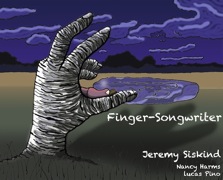 Artist: Jeremy Siskind
Artist: Jeremy Siskind
Title: Finger – Songwriter
Label: Brooklyn Jazz Underground Records
Genre: Jazz
Review by Dawoud Kringle
Not long ago, I attended Siskind’s performance at Carnegie Hall’s Weill Recital Hall (see my review here.) Now, my experience of Siskind’ss music will take a tour of his music in the recorded medium. I speak of his newest release; Finger – Songwriter.
Pianist, composer, and educator Jeremy Siskind originally from Irvine, CA, now living in NYC earned his Bachelor’s Degree from Eastman and his Master’s in English and Comparative Literature from Columbia, and studies piano with Sophia Rosoff and Fred Hersh. Siskind performs around the world as a leader and sideman. Since the 2010 release of Simple Songs, Siskind’s first CD on Brooklyn Jazz Underground Records, he placed 2nd in the Montreux Jazz Festival Solo Piano Competition, was a runner-up for the American Pianist Association’s Cole Porter Fellowship, performed at Carnegie Hall, has had his book, Jazz Etude Inspirations, published by Hal Leonard, and has become the musical director for Sandra Bernhard.
The CD opens with “One Art.” The song begins using a minor chord with descending bass line, and explores this harmonic concept with a few interesting mood shifts. Unexpectedly, Lucas Pino comes in, and adds a saxophone that glides over the understated piano accompaniment. On the third cycle of the song, Nancy Harms comes in and sings a vocal part with the quiet sadness called for in a minimal ballad. Next is “Vanished Music, Twill Water,” another ballad. Here, the instruments and vocals blend in a more seamless fashion, and concentrate on the mood of the lyrics rather than a display of musical adventurousness. The saxophone underscores the vocal and stays in the background, only occasionally commenting on the lyric. “What is that Feeling, ” a song dedicated to Jack Kerouac, is a blues. The piano and sax evoke the blues well, although there is a very slight incongruity with the vocals, as the style attempts to shift to blues while the ear is still hearing breathy ballad. Harms’ vocals introduce “A Single Moment.” This song seems to hold special significance for Siskind; as the inner CD comer has its lyrics printed on it, the only song that holds this position. The jazzy “The Inevitable Letdown” is a throwback to an older time, when jazz was the popular music of the day. His piano strides and struts like a denizen of a speakeasy, and the sax finds a comfortable place to do its own strutting. Harms’ vocals are a stark contrast to the earlier track; she belts it out with more confidence, as if portraying a brazen and life hardened hoyden. A minor chord brings us out of the speakeasy and into “Mirrors I.” Here, an oboe establishes a melody. The vocals bring an atmosphere reminiscent of the same age as the previous track, but in a European cabaret and its manifestation of the vibe of jazz within an older culture. Its end, at 1:31 is somewhat startling. A single note pulse on piano gently drives the colorful understatement of “More Mist than Moon.” It unfolds into a harmonic deconstruction with the woodwinds weaving in and out of the chords, and after journeying through its changes, ends on a pulse over which the piano fades like water. It is the most starkly adventurous composition on the CD. “Swift Winged Darkness” opens with an insinuation of a dominant chord blues, without actually becoming what it claims (or what one thinks it claims). The vocals are, as with the previous tracks, more assertive, and less breathy and understated than in the beginning of the CD. Pino makes the mood of European jazz. “Mirrors II” invokes its predecessor in “I,” but moves it into a different feel; yet ends as quickly as “I.” “Aubade” flows into the air with its Satie-esque chords. Harms return to her previous shyness, and the woodwinds float under the interplay between vocals and piano, emerging from the shadows for a solo that seems to regard the chords playing under it the way one browses through a bowl filled with jewels. The two instruments build to an intensity from which the vocals seem to fight out of confinement, and once standing atop the harmonic tussle, the song ends with startling and baffling abruptness. An upbeat interplay between vocals and winds opens “Theme for a Sunrise.” The vocals seem most happy and confident; the woodwinds offering a happy solo over the piano. The CD ends with a Billy Joel song “All You Want to do is Dance” the trio obviously having fun playing a cover of a favorite pop song.
Siskind’s piano executes every song flawlessly. But what is most appealing here is his use of the piano as a means of invocation. Having witnessed his technical pyrotechnics in a live performance, it is quite noticeable how he shifts the emphasis to service of the song. The overall effect of the recording is that of music that can be listened to casually; yet stands up very well under intense scrutiny. It’s the music that one is comfortable playing with an intimate gathering of friends, or enjoying a quiet day with a loved one, the house warm and comfortable, the schedule clear of responsibilities for the day, and outside is a cold rain storm that has no power to interrupt or ruin a perfect moment. Yet it is sophisticated, and pregnant with meaning, and never once degenerates into mere musical wallpaper.
Jeremy Siskind’s CD release show is this coming Thursday at the Cornelia Street Cafe in NY (detailed informatino here).

